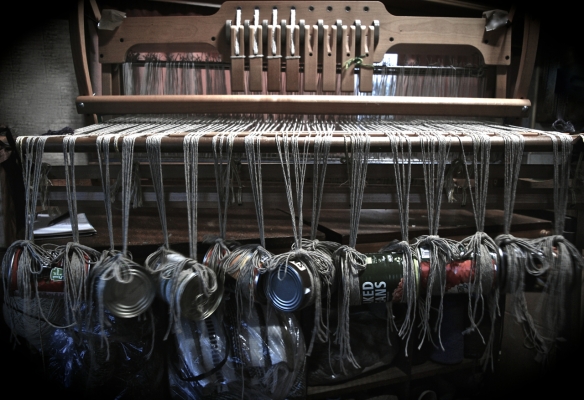‘Why are you making rugs?’ says my crofting host as I embark on rug no. 6 after a number of failures and less-than-successes. (I’ve recently written about the trickery of craft and market on No Serial Number magazine’s blog – keep an eye on my ‘Writings’ webpage and on NSN for more, too.)
I’m currently making rugs partly because I want to, need a change, enjoy the new freedom of working outside the parametres of clothing design (softness; drape; wearable colours). It’s partly because the sustainable native wools I love lend themselves to more robust weavings. It’s partly seasonal product development: because I need something that sells in the warmer months, which wearable woollens don’t so much. It’s partly because I’m thinking about home-making in a house, hopefully this winter, for some cosiness, security and, hell, some safety, actually. And it’s partly because, though I accept defeat more readily these days, I’m so near to successful rugmaking that after months’ of confidence-knocking frustration, I feel to push on through.
And so I embark on rug no. 6. I’ve got a new unbleached cotton/linen blend – it’s a pain to change warp material again, since every thread behaves differently, but I haven’t yet found out what works, and so haven’t been able to nail a constant source of warp yarn.
I generally love warp-dominant designs, so that winding the warp on the frame is about the most artistic step of the process – the bit where the seascape, or whatever it is, first emerges. However, this plain warp is easy and quick to wind (since for once I wind just one weaving’s worth at a time, to reduce frustration should things go wrong). I take special precautions and borrow some (full) tin cans to weight the warp evenly as I wind it onto the loom.

I haven’t rethreaded the heddles for months, and there are some corrections and compensations that, I finally realise, are affecting tensioning. I compensate for this in the weaving. (What’s the difference between a skilled craftsman and a bodger?) It’s still not technically perfect, but it works, is robust, flat, and I like the character.
The Hebrides are famous for their machairs: in this peaty, treeless, topsoilless, rocky moonscape, a rainbow of wildflowers emerges like the Milky Way in summer. Out here on the west coast, the dark, iron-rich soil behind the sand dunes is sprinkled constantly with sand by the Atlantic gales. The sand, being crushed shells, is lime, and so alkalises the otherwise acid soil, creating the perfect bed for ragged robin, huge red clover, dwarf harebells, golden rod, eyebright, self-heal, louse wort, ragwort, wild thyme, buttercup, hawkbit, silverweed, plantain, meadoseeet, umbellifers, trefoils, vetches and more others than I can name. The Caribbean weather departed not long after I arrived here in June, but these eruptions of colour are all the merrier against gunmetal seas and skies. I was strategic, and though the machairs have gone to seed now, for once I took photos in time, and before, rather than after, making the weaving.
So here it is, the first machair rug: https://www.etsy.com/uk/listing/637779291/machair-wool-floor-rug-handwoven-in



I’m also here for the folk music, and stay in Stornoway for five days over the HebCelt festival. I haven’t actually permitted myself time off, and have a to-do list and no arena ticket, but in between using the laundry, the library and the arts centre Wifi, I enjoy fringe events such as Gaelic singing workshops, young-peopled ceilidhs and music-rocked pubs. I make new friends (travelling and local) and bump into old ones who put me on the guestlist for the arena. However Mercury is retrograde, wires are crossed, and I’m disappointed on the gate, left to wander in the warm, wet castle woods that rave with the sound of some superb trancy folk acts that I can’t attend. I go lonely to one of the few pubs I’m comfortable in as a woman alone and play their piano for an hour, staring out at the grey-harbour rain, and feel better – or at least lonely in the way that proper musicians probably feel, which is better than ordinary mortal loneliness. Maybe if householding is an unrealistic dream I’ll go for studying folk music instead, and at least then be insecure doing the thing that I *really* love.
But then things liven up again on the weaving front: first I’m interviewed for a magazine article – a sensitive and passionate piece on me, maker politics and global economics by Kate Stuart will appear in the October print edition of No Serial Number magazine. a photo of my tools is featured in an ad on American TV; a residency opportunity opens up, filming for the BBC; I go on a promotion blitz (get in touch if you want to help in exchange for some weaving credit); I see inspiration for weavings all around; I’m fired up with ideas for the Green Cloth Collective; I pitch a number of articles about landscape medicine and craft economics… So much to do. I’ll tell you next time what transpires.







